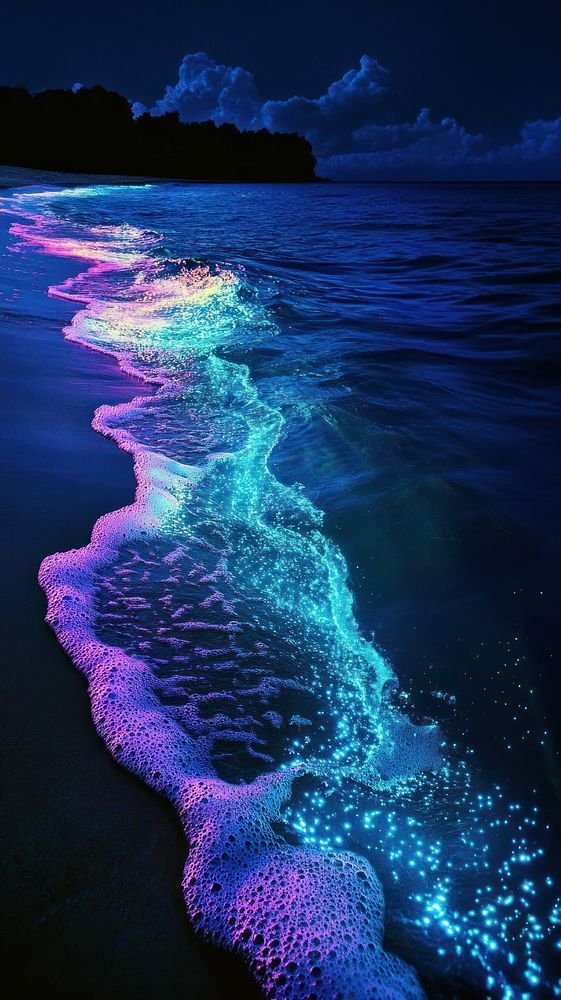Nature’s Nighttime Light Show
Introduction: A World Illuminated
Beneath the waves of the world’s oceans lies a breathtaking spectacle that many people never see: bioluminescence. This natural phenomenon allows certain marine organisms to produce their own light, transforming the dark ocean into a glowing, living wonderland. From tiny plankton to large deep-sea predators, bioluminescence plays crucial roles in survival, communication, and reproduction. In this article, we explore the magical world of glowing oceans, revealing how and why marine life illuminates the night.
What is Bioluminescence?
Bioluminescence is the production and emission of light by living organisms. In the ocean, it occurs when chemicals such as luciferin react with oxygen in the presence of the enzyme luciferase, producing light without heat. Unlike sunlight, bioluminescent light is cold and often visible only in the dark depths of the ocean. While it may seem purely decorative to us, this light serves essential purposes for marine animals. It is estimated that over 75% of deep-sea creatures possess the ability to produce bioluminescence, making it one of the most widespread adaptations in the ocean.
Glowing Plankton: The Ocean’s Fireflies
Some of the most famous examples of bioluminescence are dinoflagellates, tiny plankton that glow when disturbed. When waves crash or a boat passes, these microscopic organisms emit a blue or green light, creating a glowing trail in the water. Beaches around the world, including in the Maldives, Puerto Rico, and Japan, are known for these natural light shows, drawing tourists to witness the ethereal glow. These planktonic displays are often referred to as “marine fireworks,” enchanting observers and offering a rare glimpse of the ocean’s hidden magic.
Communication in the Deep
Bioluminescence is not just for decoration — it is a form of communication. Many deep-sea fish, including the anglerfish and lanternfish, use light to signal each other, attract mates, or warn predators. Certain squid species flash patterns of light to communicate with their peers, while some jellyfish use bioluminescence to signal danger. In the pitch-black depths, where other forms of communication are nearly impossible, light becomes a language of survival. These glowing signals allow animals to coordinate hunting, mating, and evasion with remarkable efficiency.
Camouflage in the Dark
Some marine creatures use bioluminescence as camouflage, a strategy known as counter-illumination. Animals like the hatchetfish produce light on their undersides to match the faint glow of the ocean surface, making them nearly invisible to predators below. This adaptation is vital in the deep sea, where survival often depends on remaining undetected. Counter-illumination demonstrates how evolution has harnessed light not only for attraction but also for concealment, showing the incredible ingenuity of life in extreme environments.
Luring Prey: Nature’s Glowing Traps
Many deep-sea predators use bioluminescence to hunt. The anglerfish, for example, has a luminous lure extending from its head that draws curious prey close enough to be captured. The viperfish uses glowing photophores along its body to attract small fish, while some squid species flash lights to hypnotize or confuse their targets. In the ocean’s darkness, light is a powerful tool, providing both offense and defense. These glowing hunting strategies illustrate the diverse ways marine life has evolved to thrive in environments devoid of sunlight.
Defense Mechanisms: Light as Protection
Bioluminescence also serves as a defensive mechanism. Certain squid and small fish eject glowing clouds or streaks of light to distract predators and make their escape. Some species flash bright light to temporarily blind or confuse attackers, while others produce flashes to mimic larger animals, deterring potential threats. Even the microscopic plankton use bioluminescence defensively — a sudden burst of light can attract larger predators that may prey on their original attacker. In this way, glowing becomes a survival tactic, an ingenious use of light to navigate life-and-death situations.
Glow of the Giants: Large Bioluminescent Creatures
While many bioluminescent organisms are tiny, some giants of the deep ocean glow as well. Certain jellyfish, like the lion’s mane jellyfish, stretch tens of meters across and emit a delicate, ghostly light. The firefly squid, found in Japan, congregates in large swarms, creating a mesmerizing display of blue light that turns the coastline into a glowing spectacle. Even some species of deep-sea sharks possess light-producing organs called photophores, which help them hunt or camouflage. These luminous giants remind us that bioluminescence is a feature of both small and large oceanic life.
The Science Behind the Glow
Scientists are fascinated by bioluminescence because it provides insights into evolution, chemical biology, and ecology. The chemical reaction behind the glow has inspired medical and technological research. For example, bioluminescent proteins like green fluorescent protein (GFP) have become invaluable tools in molecular biology, helping researchers track cellular processes in real-time. Studying bioluminescent organisms also sheds light on how life can adapt to extreme conditions, offering clues for understanding life in other environments, including outer space.
Ecotourism and Nighttime Light Shows
Bioluminescent phenomena are increasingly attracting human fascination. Tourists flock to glowing bays and beaches to witness the phenomenon, and night-time boat tours highlight the glowing wake left by disturbed plankton. Locations such as Mosquito Bay in Puerto Rico, the Maldives, and certain bays in Thailand have become iconic destinations for bioluminescent tourism. Responsible tourism initiatives are essential, however, to protect these delicate ecosystems while allowing people to marvel at nature’s light show.
Threats to Bioluminescent Oceans
Despite their magical appearance, bioluminescent organisms face serious threats. Pollution, climate change, and overfishing disrupt the ecosystems that support them. Chemical runoff can harm plankton populations, while warming waters alter migration and reproduction cycles. The destruction of habitats, such as coral reefs, reduces the diversity of bioluminescent life. Preserving these glowing organisms is crucial, as they are not only vital components of marine food webs but also part of the natural heritage that inspires science, art, and wonder.
Cultural Significance and Mythology
Bioluminescent oceans have influenced culture and mythology for centuries. Ancient sailors often described glowing waters as magical or ominous, interpreting them as omens or signs from the gods. Today, glowing oceans inspire artists, photographers, and filmmakers, becoming central to works that explore the mystery and beauty of the sea. The phenomenon bridges science and imagination, showing that even in the darkest places on Earth, light and creativity can thrive.
Future of Bioluminescent Research
With advances in technology, scientists are now exploring deeper and more extensively than ever before. Remotely operated vehicles, underwater drones, and specialized cameras allow researchers to document bioluminescence in previously unreachable parts of the ocean. Each new discovery uncovers new species, new behaviors, and new applications for bioluminescent chemistry. As we continue to explore, we may learn how to harness this natural light for sustainable technology, medicine, and environmental monitoring.
Conclusion: Nature’s Living Light Show
Bioluminescent oceans are among the most captivating phenomena on Earth. From glowing plankton and jellyfish to luminous deep-sea predators, these organisms illuminate the night in both literal and metaphorical ways. They are a testament to evolution’s creativity, demonstrating how life can thrive in the harshest and darkest environments. Protecting these glowing wonders is vital, not only for marine ecosystems but also for the inspiration, knowledge, and beauty they bring to the world. The oceans’ natural night-time light show reminds us that even in the deepest, darkest corners of our planet, life can shine brilliantly.


